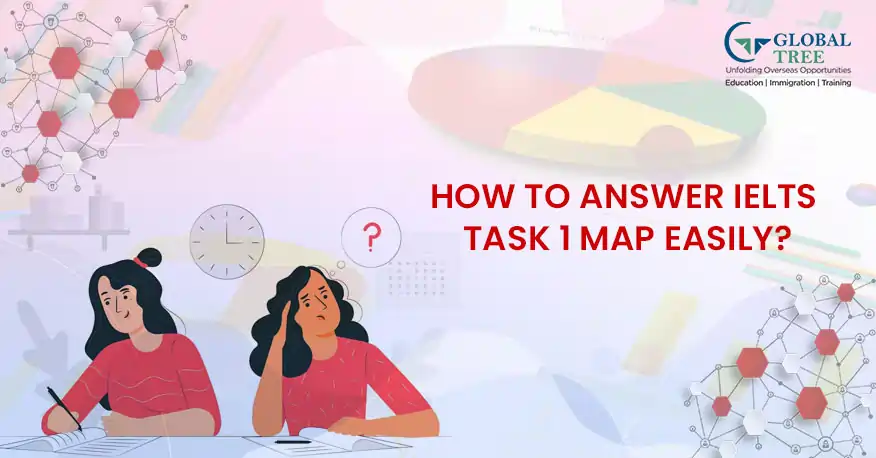Mastering IELTS Task 1 Maps: A Step-by-Step Guide to Effortless Answers

Introduction
Many candidates for the IELTS Writing Task 1 Maps report feeling overwhelmed and unclear of how to handle this particular question type in the test. Answering questions for IELTS Task 1 Maps can, however, become simpler and less intimidating if you use a methodical approach and get enough of practice. In this extensive tutorial, we will take you through a step-by-step procedure that will equip you with the confidence necessary to conquer the IELTS Task 1 Maps. We hope to prepare you with the knowledge and abilities essential to excel in this area of the IELTS exam by focusing on the organization of your response, knowing the right tenses to employ, analyzing a sample map, and giving a well-crafted sample answer.
5 Steps to Answer IELTS Task 1 Map Questions
It is essential to build a structured approach that helps you to present your solution in a way that is understandable and consistent if you wish to perform well on the IELTS writing Task 1 Maps section of the exam. In order to better understand the procedure, let's split it down into the following steps:
Step 1: Give a Clear Introduction
To begin, provide a clear and succinct introduction that places the map within its larger context. Specify the time period that corresponds to the site shown on the map, and provide its identification. If it is relevant, mention any substantial changes that have taken place or any trends that are readily apparent. You can easily crack the IELTS Writing task 1 by following the best IELTS writing tips.
Step 2: Write up a Quick Summary
It would be helpful if you could give a quick summary of the important aspects that are depicted on the map. This should include a synopsis of the most significant changes or patterns that may be seen at first sight. The overview's primary function is to supply the reader with a high-level comprehension of the information that is displayed on the map.
Step 3: Include Specifics and Contrasting Examples
Dissect the map into distinct portions or regions, and then explain the shifts or developments that are taking place in each one. It is essential to both provide pertinent details and make comparisons across various geographical locations or time eras. When expressing the degree of change, use language that is suitable, such as "a significant increase," "a gradual decline," or "a sharp rise." Choose the best IELTS coaching centre in Hyderabad to crack the exam
Step 4: Provide Concise Concluding Remarks
Provide a concise summary of the key discoveries made using the map, putting special emphasis on the most important shifts or trends discovered. This section should provide a cohesive and conclusive finale to your response by tying together the material that was offered in the overview and the details.
Step 5: Use Appropriate Tenses
- It is vitally important to utilize the appropriate tenses when describing maps in order to express the timing of the information in a correct manner. The following tenses are those that are typically utilized in IELTS Writing Task 1 Maps:
- Simple past: When describing events or transformations that took place in the past, you should use the past simple tense. For instance, "Between the years 2000 and 2010, there was a significant decrease in the number of parks."
- Use the present simple tense to talk about things that won't change in the future, such as permanent characteristics or information that hasn't altered. Take, for instance, the phrase "The river flows through the center of the city."
- Use the present perfect tense to talk about changes that started in the past but are still going on in the present. Take, for instance, the statement that "the population has been steadily increasing since the year 1990."
(Read more: How to Calculate IELTS band score?)
IELTS Writing Task 1 Map Sample Answers
Let's examine a sample map and break it down into its component parts to better understand the ideas that were presented earlier.
[Include a picture of an example map here, as well as a description of it in detail]
Example of a Response
Now that we have learned the material, let's put it to use by constructing a sample answer for the map that was provided. By carefully adhering to the procedure that was given earlier, we will be able to produce a detailed and well-structured answer that does an excellent job of communicating the information that was presented on the map. You should always focus and learn top Synonyms to Strengthen Your Vocabulary for IELTS Exam
Sample Map Description
The map provided depicts the changes in a city's transportation infrastructure between the years 2000 and 2020. The map is divided into four sections, each representing a different mode of transportation: roads, railways, bicycle lanes, and pedestrian walkways. The map showcases the expansion and development of these transportation networks over the given time period.
Sample Answer
Introduction
The map illustrates the transformation of a city's transportation infrastructure from 2000 to 2020. It focuses on the expansion and development of roads, railways, bicycle lanes, and pedestrian walkways throughout this period.
Overview
Overall, there have been significant improvements and expansions in the city's transportation networks. The road network has witnessed substantial growth, while the railway system has expanded both within the city and to surrounding areas. Bicycle lanes and pedestrian walkways have also been introduced to enhance alternative modes of transportation.
Details and Comparisons
Roads
In 2000, the road system consisted of a few main roads connecting different areas of the city. However, by 2020, there has been a substantial increase in the number and size of roads. Several new roads have been constructed, providing better connectivity between previously isolated regions. Notably, a new highway has been built on the eastern side of the city, linking it to neighboring towns.
(Read more: Check Section-wise preparation tips for IELTS Exam)
Railways
The railway system has seen significant growth over the years. In 2000, there were only a few railway lines connecting the city center with a few suburban areas. However, by 2020, the railway network has expanded both within the city and beyond. New railway lines have been added, extending connectivity to distant suburbs and neighbouring towns. Additionally, a high-speed rail line has been introduced, connecting the city to a major regional hub.
Bicycle Lanes
To encourage eco-friendly transportation options, the city has invested in developing bicycle lanes. In 2000, there were minimal dedicated lanes for cyclists. However, by 2020, a comprehensive network of bicycle lanes has been established throughout the city. These lanes offer safe and convenient routes for cyclists, connecting residential areas, parks, and commercial districts.
Pedestrian Walkways
The improvement of pedestrian infrastructure has also been a priority. In 2000, pedestrian walkways were limited, with most areas lacking designated spaces for pedestrians. However, by 2020, the city has introduced an extensive network of pedestrian walkways. These walkways meander through parks, along the waterfront, and in busy commercial areas, ensuring a safer and more enjoyable experience for pedestrians.
(Read more: Tips for how to answer IELTS advantage disadvantage essay)
Conclusion
In conclusion, the map highlights the remarkable progress made in the city's transportation infrastructure between 2000 and 2020. The expansion of roads, railways, bicycle lanes, and pedestrian walkways has significantly improved connectivity, accessibility, and sustainable transportation options.
Comments
Keep in mind that despite the fact that the format and strategy that are described in this guide can be of incredible assistance, it is absolutely necessary to modify them in accordance with the particular specifications and guidelines that are included in the IELTS examination. In addition, engaging in routine practice with a variety of map scenarios can assist you in becoming more at ease and proficient in responding to IELTS Task 1 Map questions.
Conclusion
A vital skill that can considerably improve your score in the Writing section with best IELTS exam preparation is the ability to master the art of responding to IELTS Task 1 Maps. You can build the self-assurance and expertise you need to answer any map question that comes your way by following the step-by-step process that is outlined in this guide, organizing your response effectively, understanding the appropriate tenses to use, analyzing sample maps, and practicing with various scenarios.
You can obtain the results you want to get on the IELTS Task 1 Maps if you keep at it, practice a lot, and make sure you have a good comprehension of the tactics that are described in this tutorial. Keep in mind that you should approach each map question with a level head and a methodical mindset in order to give yourself the opportunity to demonstrate your analytical ability and linguistic prowess.
Lastly, maintaining a regular practice routine is absolutely necessary for developing your skills. The more you participate in Task 1 Maps, the more at ease and confident you will get in approaching and responding to their questions. In order to acquaint yourself with the requirements of the IELTS Writing part, you should look for extra resources, use practice materials, and replicate the conditions of the exam. Follow the IELTS preparation Tips to get a good score.
I wish you the best of success with your IELTS adventure and hope that you do exceptionally well in all parts of the exam.









